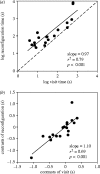Doing the twist: A test of Darwin's cross-pollination hypothesis for pollinarium reconfiguration
- PMID: 17148328
- PMCID: PMC1617176
- DOI: 10.1098/rsbl.2005.0385
Doing the twist: A test of Darwin's cross-pollination hypothesis for pollinarium reconfiguration
Abstract
Mating success in plants depends largely on the efficiency of pollen dispersal. For hermaphrodite plants, self-pollination, either within or among flowers, can reduce mating opportunities because of pollen and ovule discounting and inbreeding depression. Self-pollination may be particularly detrimental in plants such as orchids and asclepiads that package each flower's pollen into one or more pollinia which, together with accessory structures, comprise a pollinarium. Darwin proposed that physical reconfiguration of pollinaria serves as a mechanism for reducing the likelihood of self-pollination. To be effective, the time taken for pollinarium reconfiguration would need to exceed that spent by a pollinator on a plant. We investigated pollinarium reconfiguration (including pollinarium bending, pollinium shrinking and anther cap retention) in 19 species and found a strong positive relationship between reconfiguration time and the duration of pollinator visits. Reconfiguration times were also consistently longer than pollinator visit times. These results provide strong support for Darwin's idea that this mechanism promotes cross-pollination.
Figures


Similar articles
-
Anther cap retention prevents self-pollination by elaterid beetles in the South African orchid Eulophia foliosa.Ann Bot. 2006 Mar;97(3):345-55. doi: 10.1093/aob/mcj041. Epub 2005 Dec 22. Ann Bot. 2006. PMID: 16373371 Free PMC article.
-
The effects of nectar addition on pollen removal and geitonogamy in the non-rewarding orchid Anacamptis morio.Proc Biol Sci. 2004 Apr 22;271(1541):803-9. doi: 10.1098/rspb.2003.2659. Proc Biol Sci. 2004. PMID: 15255098 Free PMC article.
-
Phenotype-fitness relationships and pollen-transfer efficiency of five orchid species with different pollination strategies.Am J Bot. 2023 Jun;110(6):e16198. doi: 10.1002/ajb2.16198. Epub 2023 Jun 21. Am J Bot. 2023. PMID: 37342959
-
Mechanisms and evolution of deceptive pollination in orchids.Biol Rev Camb Philos Soc. 2006 May;81(2):219-35. doi: 10.1017/S1464793105006986. Biol Rev Camb Philos Soc. 2006. PMID: 16677433 Review.
-
On the success of a swindle: pollination by deception in orchids.Naturwissenschaften. 2005 Jun;92(6):255-64. doi: 10.1007/s00114-005-0636-y. Naturwissenschaften. 2005. PMID: 15931514 Review.
Cited by
-
Large pollen loads of a South African asclepiad do not interfere with the foraging behaviour or efficiency of pollinating honey bees.Naturwissenschaften. 2012 Jul;99(7):545-52. doi: 10.1007/s00114-012-0932-2. Epub 2012 Jun 28. Naturwissenschaften. 2012. PMID: 22739706
-
Anther cap retention prevents self-pollination by elaterid beetles in the South African orchid Eulophia foliosa.Ann Bot. 2006 Mar;97(3):345-55. doi: 10.1093/aob/mcj041. Epub 2005 Dec 22. Ann Bot. 2006. PMID: 16373371 Free PMC article.
-
Pollination mechanism in Serapias with no pollinaria reconfiguration.AoB Plants. 2023 Aug 16;15(5):plad054. doi: 10.1093/aobpla/plad054. eCollection 2023 Oct. AoB Plants. 2023. PMID: 37899971 Free PMC article.
-
A pollinator shift explains floral divergence in an orchid species complex in South Africa.Ann Bot. 2014 Jan;113(2):277-88. doi: 10.1093/aob/mct216. Epub 2013 Oct 9. Ann Bot. 2014. PMID: 24107684 Free PMC article.
-
A generalized deceptive pollination system of Doritis pulcherrima (Aeridinae: Orchidaceae) with non-reconfigured pollinaria.BMC Plant Biol. 2012 Jul 3;12:67. doi: 10.1186/1471-2229-12-67. BMC Plant Biol. 2012. PMID: 22571550 Free PMC article.
References
-
- Ayasse M, Schiestl F.P, Paulus H.F, Lofstedt C, Hansson B, Ibarra F, Francke W. Evolution of reproductive strategies in the sexually deceptive orchid Ophrys sphegodes: how does flower-specific variation of odor signals influence reproductive success? Evolution. 2000;54:1995–2006. - PubMed
-
- Barrett S.C.H. Sexual interference of the floral kind. Heredity. 2002a;88:154–159. doi:10.1038/sj.hdy.6800020 - DOI - PubMed
-
- Barrett S.C.H. The evolution of plant sexual diversity. Nat. Rev. Genet. 2002b;3:274–284. doi:10.1038/nrg776 - DOI - PubMed
-
- Barrett S.C.H, Harder L.D. The evolution of polymorphic sexual systems in daffodils (Narcissus) New Phytol. 2005;165:45–53. doi:10.1111/j.1469-8137.2004.01183.x - DOI - PubMed
-
- Bateman R.M, Hollingsworth P.M, Preston J, Yi-Bo L, Pridgeon A.M, Chase M.W. Molecular phylogenetics and evolution of Orchidinae and selected Habenariinae (Orchidaceae) Bot. J. Linnean Soc. 2003;142:1–40. doi:10.1046/j.1095-8339.2003.00157.x - DOI
Publication types
MeSH terms
LinkOut - more resources
Full Text Sources
Miscellaneous

